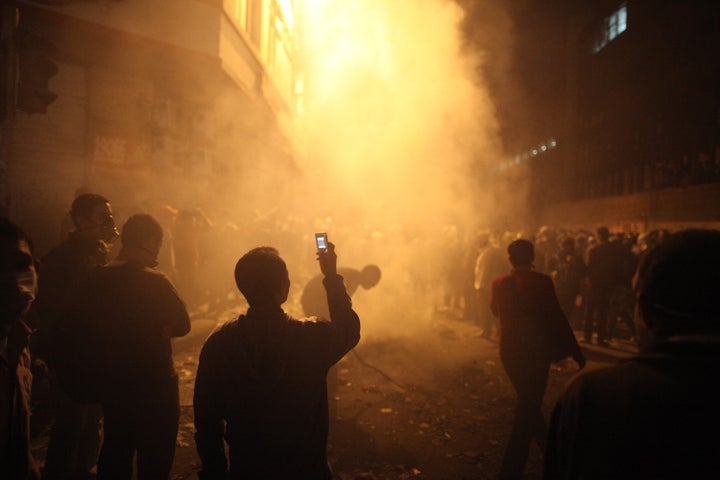
For an activist like me the sensation of walking across the 6 October Bridge and into Tahrir Square at the height of last month's 'second revolution' was equivalent to how an Elvis fan must feel arriving at Gracelands for the first time. In January and February I'd followed the unfolding 'first Egyptian revolution' from afar reading the breathless tweets and status updates of friends on the ground with equal parts excitement and jealousy. I was fortunate enough to spend an inspiring week at the Wall Street occupation at the time of the Brooklyn Bridge arrests and was back in London for the start occupation of the London Stock Exchange. In both Zuccotti Park and St Paul's fluttering Egyptian flags paid tribute to a key source of inspiration, but to actually be in a packed Tahrir Square, one of the birthplaces of the Arab Spring and spiritual home of the Occupy movement, was something very special.
I was in Egypt for the run up to the first stage of Egypt's first post-Mubarak parliamentary elections and arrived in Cairo just as five days of violence between the military and protesters in Tahrir Square were coming to an end. After bloody battles on Wednesday, soldiers had been ordered to end their attempts to clear Tahrir Square. Although the crowd in square on Thursday was large, there was a nervousness in the air with rumours circulating about possible military tactics and the nature of the invisible odourless gas used over the previous days which had caused painful rashes, temporary blindness and seizures. Was it a form of nerve gas? Had it been pumped into the square through the subway ventilation shafts? What might be the long-term effects?
Some streets around the square were still littered with burnt out cars, piles of rubble and blacked shop fronts. The army had blocked off Mohamed Mahmoud Street - the route to the Ministry of the Interior - with razor wire and protesters had strung a banner across its entrance: "Eyes of Freedom Street." This banner commemorated the 49 protesters who had lost eyes over the previous week after being targeted with birdshot and it was striking to see how many people in Tahrir Square had patches over one eye, their resolve undiminished by partial blindness.
The mood on Friday was much more buoyant. As people streamed into Tahrir Square, the crowd grew to a size the like of which had not been witnessed since February. Young men climbed on top of lamp-posts, waving flags and continuous rhythmic chanting echoed off the buildings. At lunchtime, in an unprecedented move, the grand Imam of Al-Azhar, Sunni Islam's highest authority, arrived in the square to lead tens of thousands in Friday prayer.
Later that afternoon, in a move reminiscent of OLSX's occupation of Finsbury Square or the attempts by OWS protesters to occupy Wall Street on 5th October, a breakaway group of around a hundred protesters walked the 500 metres to the Egyptian Parliament and Cabinet and occupied the street that runs between the two buildings. By evening their number had swelled tenfold and handful of soldiers looked on as protesters set up tents, laid out blankets and sprayed graffiti onto Parliament's whitewashed walls. Volunteers weaved through the crowd passing out water, dates and other food as well as blankets for those who were planning to camp down.
Back in Tahrir the crowd remained large but the mood had become more tense. There was talk of "thugs" mingling with the crowd, harassing people, robbing and starting fights. I left the square after midnight only to return the next morning to the news that one of the protesters I had been with the previous night at the occupation outside Parliament and the Cabinet - 19 year old Ahmed Sayd Sonour - had been killed, crushed beneath the wheels of a Ministry of Interior armoured personnel carrier. Someone had traced around the outline of his blood on the tarmac with chalk.
His death followed that over 40 others across Egypt who had died at the hands of the security forces over the course of that week. Protesters had originally come out on to the streets to oppose proposed constitutional amendments by the military led transitional government (the Supreme Council of the Armed Forces or SCAF) which would limit the authority of future governments over the army. They were also expressing anger at SCAF's slow timetable for implementing civilian rule and their blatant lack of respect for human rights over their nine months in power.
The clashes had succeeded in persuading SCAF to make some limited concessions. Essam Sharaf's unpopular civilian cabinet resigned, and a new Prime Minister, Kamel el-Ganzoury was appointed and charged with forming a so-called National Salvation Government. The date for presidential elections was shifted from early 2013 to June 2012. But for the protesters in Tahrir Square this fell far short of their demand for an end to military rule. "Ganzoury is a puppet and I don't trust SCAF to hand over power" political activist Salma Hegazy told me. "They will use these elections to give the impression of backing democracy whilst doing everything they can to keep the influence and privileges."
On Sunday night, the eve of the elections, there was a heavy downpour of rain which washed away the remnants of blood from the streets but also created large pools of water in Tahrir Square and at the occupation site outside Parliament and the Cabinet. As soon as the rain stopped dozens of volunteers equipped with buckets, brooms and whatever they could find began a frenzy of clearing. Within an hour the lakes of water had gone and the crowd cheered their appreciation.
Although there had been calls from some quarters for an electoral boycott polling day saw a high turn out with queues of people began snaking around polling stations even before doors had opened. During the elections the crowd in Tahrir Square was much smaller than it had been on preceding days. There were still groups chanting and flags waving as well as clusters of people engaged in heated debate. One of the main discussions amongst activists in Tahrir centred on whether voting would lend legitimacy to an election that, no matter the result, will see SCAF retaining ultimate power. Feelings ran high but despite differences of opinion all agreed that military rule must end and most agreed that the Tahrir Square occupation should continue until such time that it does. "To dismantle our tents before then would be to dismantle our hopes for a better future" Mourad Haikal told me. "Whatever happens in the elections the important thing is that Tahrir should stay."
As polling stations closed their doors on Tuesday night the mood in Cairo was far from celebratory. Despite a turnout of 62 percent and widespread relief that the two days of voting had not been marred by violence, the elections had left many far from satisfied. Beyond the concerns at voting irregularities and overly complicated ballot papers, many felt that the election process - due to go on for another three months - lacks legitimacy.
The results, released the following Sunday, showed that Islamic parties took a total of 65 percent of the vote pushing the coalition of liberal parties into third place. Whilst the Muslim Brotherhood's Freedom and Justice Party (FJP) performed as expected winning the largest share of votes with 36.6 percent, it was the 24.4 percent of votes won by the ultraconservative Salafist Nour Party that caused the greatest surprise. Whilst the FJP advocate the application of some aspects of Sharia law they have made efforts to position themselves as a moderate, democratic and inclusive party. The Salafists, by contrast, take a more hard line approach rejecting the very concept of democracy which they believe allows man-made law to take ascendance over God's law. "The extremist Islamic parties would attempt to kill democracy by democracy" political analyst Ahmed Abdel Maksood tells me. "If they were to win a parliamentary majority they would amend the constitution and bring in an Islamic State."
Despite the first round of election results political analyst Adam Taylor-Awny remains optimistic "I am hoping that as soon as the different political parties realise that they have wasted their efforts in an election which has not given them any power they will realise that their legitimacy is derived from the street, and will join us in a unified effort to remove the military junta and replace it with a civilian government which is able to implement some of the key demands of the revolution" he says.
Last months' return to Tahrir Square not only succeeded in reawakening the spirit of defiance in Egypt and achieving some significant political gains but also cemented the position of Tahrir Square as a permanent practical and symbolic heart of the freedom movement in Egypt: a place to which people can always return and whose very existence will help shape Egyptian politics for generations to come. As Ahmed Abdel Maksood puts it, "the January revolution gave us the path. It showed us the way. We now have a weapon and that weapon is called Tahrir Square."
Before I leave Cairo I return to the square for a final time. The tents were still there but the crowds have dwindled significantly and many of the traders have moved on. "We must be patient" a young woman tells a small group. "This stage of the revolution will not be over in eighteen days." Her nostrils are clogged with tissue to soak up the blood from a nose bleed caused by inhaling tear gas some days earlier. "Once a nation decides to live, destiny has no choice other than to oblige" she continues. But as the situation in Egypt demonstrates, destiny's path is not always a straight one.
